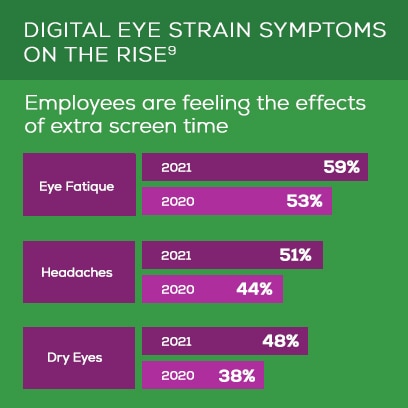Even before the COVID-19 pandemic, the number of hours we spent staring at screens was causing serious vision issues. And it’s only getting worse.1 While working from home has been good for slowing the disease, our eyes are paying a price.
At one time, digital eye strain was a hazard reserved for office workers and tech developers. Today it affects almost everyone, with children being especially vulnerable.2
To put it in perspective, a recent Transitions Optical Workplace Wellness Study found that since the pandemic, over half of employees spend more time in front of their work computer screens. Among those, 85% say they are experiencing more digital eye strain.3 And with good reason: Americans spend an average of 11.8 hours per day looking at computers, phones, tablets and other electronic devices.4 Compared to 8.36 hours of screen time per day in 2017, it’s easy to see what’s causing the problem.5
Computer Vision Syndrome
According to the American Optometric Association, increased screen time can lead to Computer Vision Syndrome — eye strain, dry eyes, eye irritation, blurred vision and double vision.6 And uncorrected vision problems can increase the severity of these symptoms. That’s why it’s more important than ever to provide employees with premium vision benefits that cover not only eyewear for common visual problems, but also lens options, such as anti-reflective coatings, blue-light filtering and photochromic lenses.

6 in 10 people say increased screen-related aches and pains leave them feeling a lot less productive7
Common symptoms of computer vision syndrome8
• Eyestrain
• Headaches
• Blurred vision
• Dry eyes
• Neck and shoulder pain
Working from home means increased screen time
With more employees working from home, virtual meetings have replaced face-to-face interactions. Lunch breaks are now spent in front of a laptop. Work-life balance has evolved into an “always-on” mentality without breaks or conversations with colleagues. And with social distance constraints keeping everyone at home, recreational screen time has increased as well. Gaming, social media and binge-watching videos keeps us glued to the screen even after work. People can conceivably be in front of a screen nearly the entire day.
Remote learning and children's eyes
Distance learning has increased the number of children experiencing Computer Vision Syndrome. Time previously spent in the classroom or on the playground is now spent in front of a screen. And parents who would normally limit screen time now have little choice but to relinquish some of that control.
Eye doctors are also seeing an increase in childhood myopia cases — often caused by long hours of “up close” work. Progressing at faster-than-expected rates, some doctors suggest that increased screen time and limited time spent outdoors may be to blame.10
How to treat Computer Vision Syndrome
In addition to taking vision breaks every 20 minutes, see an eye doctor who can diagnose any issues that might be contributing to digital eye strain. For many, computer eyeglasses are the answer. Different than “readers,” computer glasses are optimized for digital screens that are 20"-24” away and often have blue-light filtering and anti-glare lenses.11
To help employees prevent and treat digital eye strain, contact your EyeMed rep or visit eyemed.com.
••••
1 - Julie Bos, “Soaring Screen Time,” Vision Monday, September 21, 2020.
2 - Julie Bos, “Soaring Screen Time,” Vision Monday, September 21, 2020.
3 - Jonathan Ormsby, “When Screen Time Is All the Time: Eyestrain Is the Name of the Game,” HR Daily Advisor, July 6, 2021.
4 - Stephen Miller, “Screen Time Takes Toll on Workers’ Eyes,” SHRM, February 10, 2020.
5 - Eyesafe, “COVID-19 Screen Time Spikes to Over 13 Hours Per Day,” March 28, 2020.
6 - “Computer Vision Syndrome,” American Optometric Association, Accessed September 16, 2021.
7 - “Quarantined Americans Are Actively Trying to Cut Down Their Screen Time,” SWNS Digital, September 2, 2020.
8 - “Computer Vision Syndrome,” American Optometric Association, Accessed September 16, 2021.
9 - 2021 Transitions Workplace Wellness Survey, Conducted by Wakefield Research for Transitions Optical.
10 - Reena Mukamal, “How the COVID-19 Lockdown Changed Children’s Eyes,” American Academy of Ophthalmology, June 2, 2021.
11 - Gary Heiting, OD, and Larry K. Wan, OD, “How Computer Glasses Can Ease Digital Eye Strain,” All About Vision, Accessed September 16, 2021.




